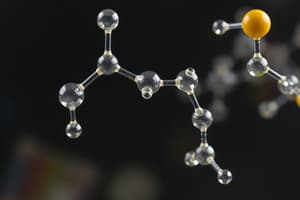Podcast
Questions and Answers
Explain how the amphipathic nature of phospholipids contributes to the formation of stable cell membranes in an aqueous environment.
Explain how the amphipathic nature of phospholipids contributes to the formation of stable cell membranes in an aqueous environment.
Phospholipids arrange into a bilayer with hydrophobic tails inward, away from water, and hydrophilic heads outward, interacting with water, creating a stable structure.
Describe the role of condensation and hydrolysis reactions in the context of synthesizing and breaking down biological macromolecules, respectively.
Describe the role of condensation and hydrolysis reactions in the context of synthesizing and breaking down biological macromolecules, respectively.
Condensation reactions link monomers by removing water, forming polymers. Hydrolysis uses water to break polymers into monomers, reversing condensation.
Outline the significance of the variable R-group in determining the unique properties and functions of different amino acids.
Outline the significance of the variable R-group in determining the unique properties and functions of different amino acids.
The R-group dictates an amino acid's size, charge, hydrophobicity, and reactivity, influencing protein folding, structure, and interactions.
Explain how the sequence of amino acids in a polypeptide chain determines the final three-dimensional conformation of a protein and why this is critical for its function.
Explain how the sequence of amino acids in a polypeptide chain determines the final three-dimensional conformation of a protein and why this is critical for its function.
Describe the structural differences between saturated and unsaturated fatty acids, and how these differences affect their physical properties and roles in biological systems.
Describe the structural differences between saturated and unsaturated fatty acids, and how these differences affect their physical properties and roles in biological systems.
Explain how the complementary base pairing rules in DNA (Adenine with Thymine, Guanine with Cytosine) are critical for DNA replication and maintaining the integrity of genetic information.
Explain how the complementary base pairing rules in DNA (Adenine with Thymine, Guanine with Cytosine) are critical for DNA replication and maintaining the integrity of genetic information.
Discuss how the properties of water, such as its high heat capacity and polarity, make it an ideal medium for life and biological processes.
Discuss how the properties of water, such as its high heat capacity and polarity, make it an ideal medium for life and biological processes.
Compare and contrast the primary structural differences between amylose and cellulose, and explain how these differences relate to their distinct functions in plants.
Compare and contrast the primary structural differences between amylose and cellulose, and explain how these differences relate to their distinct functions in plants.
Describe the role of enzymes as biological catalysts, explaining how they increase the rate of biochemical reactions and the mechanisms by which they achieve this.
Describe the role of enzymes as biological catalysts, explaining how they increase the rate of biochemical reactions and the mechanisms by which they achieve this.
Explain how changes in pH can affect the structure and function of proteins, with specific reference to enzyme activity.
Explain how changes in pH can affect the structure and function of proteins, with specific reference to enzyme activity.
Flashcards
Water
Water
A polar molecule essential for life, with properties like cohesion, adhesion, high specific heat, and solvent abilities.
Organic Compounds
Organic Compounds
A class of molecules based on carbon, including carbohydrates, lipids, proteins, and nucleic acids, essential for all known life.
Nucleic Acids
Nucleic Acids
Polymers made of nucleotide monomers. Example: DNA and RNA.
Carbohydrates
Carbohydrates
Signup and view all the flashcards
Lipids
Lipids
Signup and view all the flashcards
Proteins
Proteins
Signup and view all the flashcards
Biomolecules
Biomolecules
Signup and view all the flashcards
Study Notes
- BioNinja is a resource for IB Biology students.
- It includes course information, topics, themes, and review materials.
Course
- Syllabus Outline
- Command Terms
- Reporting Skills
- Practical Work
Topics
- Biomolecules
- Cells
- Metabolism
- Genetics
- Heredity
- Equilibrium
- Body Systems
- Plant Systems
- Biodiversity
- Nutrition
- Ecology
- Human Impacts
Themes
- Unity and Diversity
- Form and Function
- Interdependencies
- Continuity / Change
Review
- Powerpoints
- Topic Notes
- Summaries
- Worksheets
Standard Topics
- Water
- Organic Compounds
- Nucleic Acids
- Carbohydrates
- Lipids
- Proteins
Studying That Suits You
Use AI to generate personalized quizzes and flashcards to suit your learning preferences.




